2021 MERCEDES-BENZ GLC COUPE jump start
[x] Cancel search: jump startPage 326 of 481
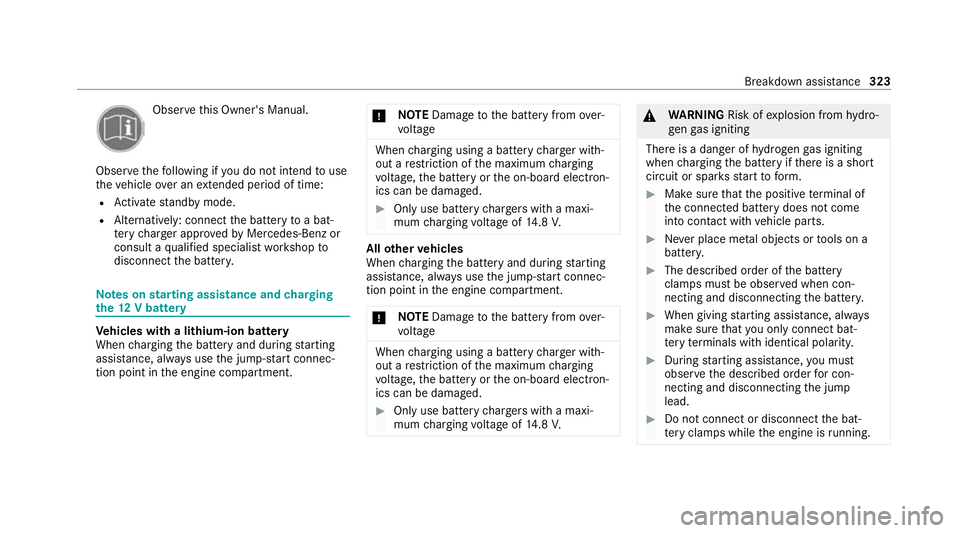
Obser
vethis Owner's Manual.
Obser vethefo llowing if you do not intend touse
th eve hicle over an extended pe riod of time:
R Activate standby mode.
R Alternatively: connect the battery toa bat‐
te ry charge r appro vedby Mercedes-Benz or
consult a qualified specialist workshop to
disconnect the batter y. Note
s onstarting assi stance and charging
th e12 V battery Ve
hicles with a lithium-ion battery
When charging the battery and during starting
assis tance, al ways use the jump-s tart connec‐
tion point in the engine compartment. *
NO
TEDama getothe battery from over‐
vo ltage When
charging using a bat tery charge r with‐
out a restriction of the maximum charging
vo ltage, the battery or the on-board electron‐
ics can be damaged. #
Only use battery charge rs with a maxi‐
mum charging voltage of 14.8 V. All
other vehicles
When charging the battery and during starting
assis tance, al ways use the jump-s tart connec‐
tion point in the engine compartment.
* NO
TEDama getothe battery from over‐
vo ltage When
charging using a bat tery charge r with‐
out a restriction of the maximum charging
vo ltage, the battery or the on-board electron‐
ics can be damaged. #
Only use battery charge rs with a maxi‐
mum charging voltage of 14.8 V. &
WARNING Risk ofexplosion from hydro‐
ge nga s igniting
There is a danger of hydrogen gas igniting
when charging the battery if there is a short
circuit or spar ksstart toform. #
Make sure that the positive term inal of
th e connected battery does not come
into conta ct withvehicle parts. #
Never place me tal objects or tools on a
batter y. #
The described order of the battery
clamps must be obser ved when con‐
necting and disconnecting the batter y. #
When giving starting assis tance, al ways
make sure that you on lyconnect bat‐
te ry term inals with identical polarity. #
During starting assis tance, you must
obse rveth e described order for con‐
necting and disconnecting the jump
lead. #
Do not connect or disconnect the bat‐
te ry cla mp s while the engine is running. Breakdown assist
ance323
Page 327 of 481

&
WARNING Risk ofexplosion during
ch arging process and starting assis tance
During thech arging process and starting
assis tance, the battery may release an explo‐
sive gas mixture. #
Avoid fire , naked flames, creating
spar ksand smoking. #
Make sure there is suf ficient ventila‐
tion. #
Do not lean over a batter y. &
WARNING Risk ofexplosion from a fro‐
zen battery
A dischar ged battery may freeze at temp era‐
tures slightly abo veor below freezing point.
During starting assis tance or battery charg‐
ing, bat tery gas can be released. #
Alw ays allow a battery tothaw before
ch arging it or per form ing starting assis‐
ta nce. If
th e indicator/warning lamps in the instrument
clus ter do not light up at low temp eratures, it is
ve ry likely that the dischar ged battery has fro‐
zen. In this case you may neither jump-s tart the
ve hicle nor charge the batter y.
The service life of a battery that has been
th awe d may be dramatically shor tened. The
st arting characteristics may be impaired, espe‐
cially at low temp eratures.
It is recommended that you ha veathaw ed bat‐
te ry checked at a qualified specialist workshop.
Plug-in hybrid: be sure toobser vethe no tes in
th e Supplement. You could otherwise failto rec‐
ognise dangers.
All vehicles
* NO
TEDama gecaused bynumerous or
ex tended attempt sto start the engine Nume
rous or extended attempt sto start the
engine may damage the catalytic con verter
due tonon-combu sted fuel. #
Avoid numerous and extended attem pts
to start the engine. Obser
vethefo llowing points during starting
assis tance and when charging the battery:
R Only use undamaged jump lead/charging
cables with a suf ficient cross-section and
insula tedte rm inal clamps.
R Non- insulated parts of thete rm inal clamps
must not come into con tact with other me tal
parts while the jump lead/charging cable is
connected tothe battery/jump-s tart connec‐
tion point.
R The jump lead/charging cable must not
come into contact wi thany parts which may
mo vewhen the engine is running.
R Alw ays make sure that nei ther you nor the
battery is elect rostatically charge d.
R Keep away from fire and naked flames.
R Do not lean overth e batter y.
Obser vethe additional following points when
ch arging the battery:
R Only use battery charge rs tested and
appr oved for Mercedes-Benz.
R Read the battery charge r's operating instruc‐
tions before charging the batter y. 324
Breakdown assis tance
Page 328 of 481
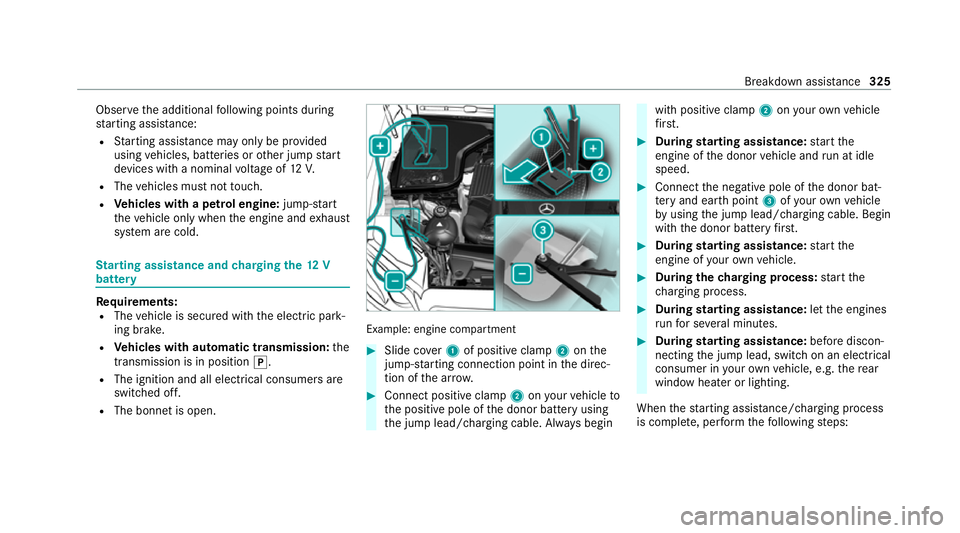
Obser
vethe additional following points during
st arting assistance:
R Starting assis tance may only be pr ovided
using vehicles, batteries or other jump start
devices with a nominal voltage of 12V.
R The vehicles must not touch.
R Vehicles with a petrol engine: jump-start
th eve hicle only when the engine and exhaust
sy stem are cold. St
arting assi stance and charging the12 V
battery Requ
irements:
R The vehicle is secured with the electric park‐
ing brake.
R Vehicles with automatic transmission: the
transmission is in position j.
R The ignition and all electrical consumers are
switched off.
R The bonnet is open. Example: engine compartment
#
Slide co ver1 of positive clamp 2onthe
jump-s tarting connection point in the direc‐
tion of the ar row. #
Connect positive clamp 2onyour vehicle to
th e positive pole of the donor battery using
th e jump lead/charging cable. Alw ays begin with positive clamp
2onyour ow nve hicle
fi rs t. #
During starting assi stance: start the
engine of the donor vehicle and run at idle
speed. #
Connect the negative pole of the donor bat‐
te ry and ear thpoint 3ofyour ow nve hicle
by using the jump lead/charging cable. Begin
with the donor battery firs t. #
During starting assi stance: start the
engine of your ow nve hicle. #
During thech arging process: start the
ch arging process. #
During starting assi stance: letthe engines
ru nfo r se veral minutes. #
During starting assi stance: before discon‐
necting the jump lead, switch on an electrical
consumer in your ow nve hicle, e.g. there ar
wind owheater or lighting.
When thest arting assis tance/charging process
is compl ete, per form thefo llowing steps: Breakdown assis
tance 325
Page 329 of 481
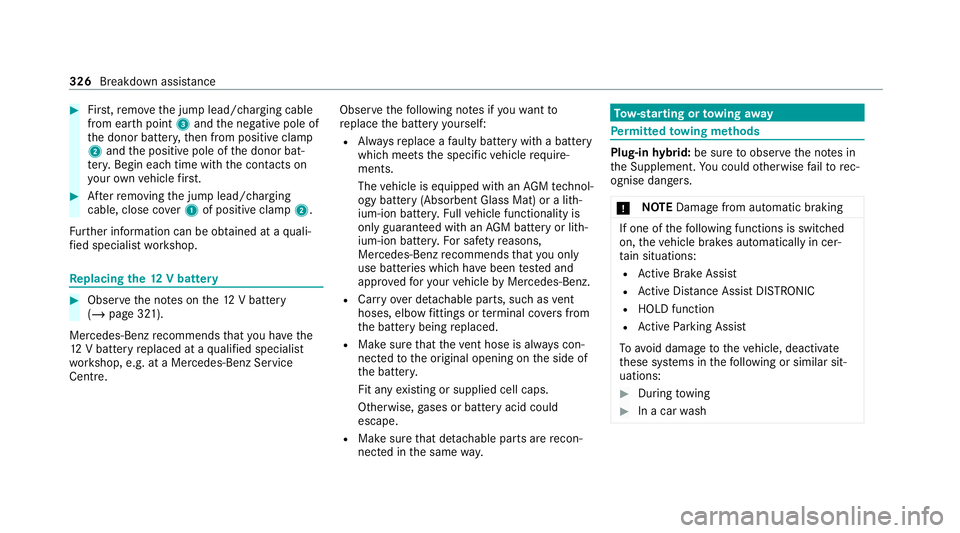
#
First,re mo vethe jump lead/charging cable
from ear thpoint 3and the negative pole of
th e donor batter y,then from positive clamp
2 and the positive pole of the donor bat‐
te ry. Begin ea chtime wi th the conta cts on
yo ur ow nve hicle firs t. #
Afterre moving the jump lead/charging
cable, close co ver1 of positive clamp 2.
Fu rther information can be obtained at a quali‐
fi ed specialist workshop. Re
placing the 12V battery #
Obser vethe no tes on the12 V battery
(/ page 321).
Mercedes-Benz recommends that you ha vethe
12 V battery replaced at a qualified specialist
wo rkshop, e.g. at a Mercedes-Benz Service
Centre. Obser
vethefo llowing no tes if youwa ntto
re place the battery yourself:
R Alw aysre place a faulty bat tery with a battery
which meets the specific vehicle require‐
ments.
The vehicle is equipped with an AGMtech nol‐
ogy battery (Absorbent Glass Mat) or a li th‐
ium-ion batter y.Fu llve hicle functionality is
only guaranteed with an AGM battery or lith‐
ium-ion batter y.Fo r saf etyre asons,
Mercedes-Benz recommends that you on ly
use bat teries which ha vebeen tested and
appr ovedfo ryo ur vehicle byMercedes-Benz.
R Carryove r de tach able parts, such as vent
hoses, elbow fittings or term inal co vers from
th e battery being replaced.
R Make sure that theve nt hose is al ways con‐
nected tothe original opening on the side of
th e batter y.
Fit any existing or supplied cell caps.
Otherwise, gases or battery acid could
escape.
R Make sure that de tach able parts are recon‐
nected in the same way. To
w- starting or towing away Pe
rm itted towing me thods Plug-in
hybrid: be sure toobser vethe no tes in
th e Supplement. You could otherwise failto rec‐
ognise dangers.
* NO
TEDama gefrom auto matic braking If one of
thefo llowing functions is switched
on, theve hicle brakes automatically in cer‐
ta in situations:
R Active Brake Assi st
R Active Dis tance Assi stDISTRONIC
R HOLD function
R Active Parking Assist
To avo id damage totheve hicle, deactivate
th ese sy stems in thefo llowing or similar sit‐
uations: #
During towing #
In a car wash 326
Breakdown assis tance
Page 384 of 481
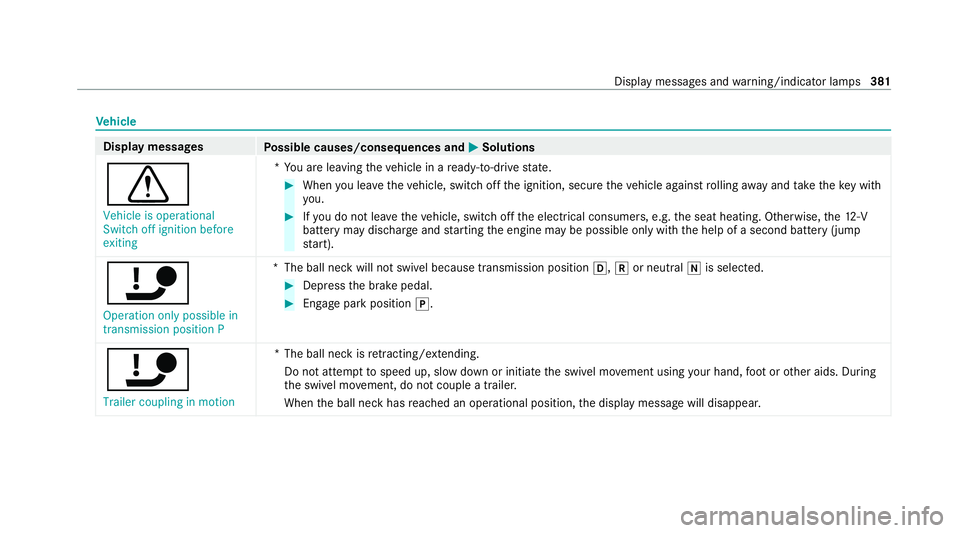
Ve
hicle Display messages
Possible causes/consequences and M MSolutions
d Vehicle is operational
Switch off ignition before
exiting *Y
ou are leaving theve hicle in a ready-to-drive state. #
When you lea vetheve hicle, switch off the ignition, secure theve hicle against rolling away and take theke y with
yo u. #
Ifyo u do not lea vetheve hicle, switch off the electrical consumers, e.g. the seat heating. Otherwise, the12 ‑V
battery may discharge and starting the engine may be possible only with the help of a second battery (jump
st art).
ï
Operation only possible in
transmission position P *
The ball neck will not swivel because transmission position h,kor neut rali is selec ted. #
Depress the brake pedal. #
Enga gepark position j.
ï
Trailer coupling in motion *T
he ball neck is retracting/extending.
Do not attem pttospeed up, slow down or initiate the swivel mo vement using your hand, foot or other aids. During
th e swivel mo vement, do not couple a trailer.
When the ball neck has reached an operational position, the display message will disappear. Display messages and
warning/indicator lamps 381
Page 418 of 481
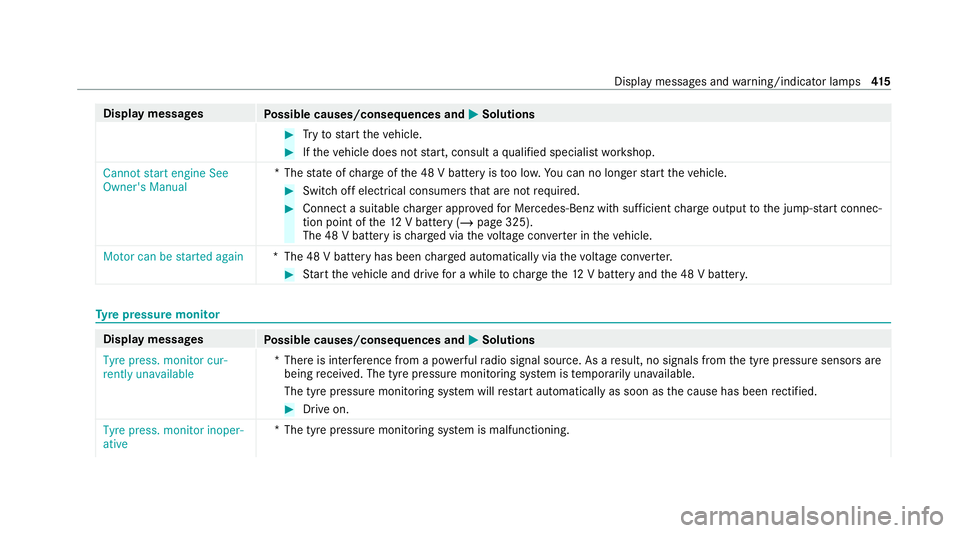
Display messages
Possible causes/consequences and M MSolutions #
Tryto start theve hicle. #
Ifth eve hicle does not start, consult a qualified specialist workshop.
Cannot start engine See
Owner's Manual *T
hestate of charge ofthe 48 V battery is too lo w.You can no lon gerst art theve hicle. #
Switch off electrical consumers that are not required. #
Connect a suitable charge r appro vedfo r Mercedes-Benz with suf ficient charge output tothe jump-s tart connec‐
tion point of the12 V battery (/ page 325).
The 48 V battery is charge d via thevo ltage con verter in theve hicle.
Motor can be started again *T
he 48 V battery has been charge d automatically via thevo ltage con verter. #
Start theve hicle and drive for a while tocharge the12 V battery and the 48 V batter y. Ty
re pressure moni tor Display messages
Possible causes/consequences and M MSolutions
Tyre press. monitor cur-
rently unavailable *T
here is inter fere nce from a po werful radio signal source. As a result, no signals from the tyre pressure sensors are
being recei ved. The tyre pressure monitoring sy stem is temp orarily una vailable.
The tyre pressure monitoring sy stem will restart automatically as soon as the cause has been rectified. #
Drive on.
Tyre press. monitor inoper-
ative *T
he tyre pressure monitoring sy stem is malfunctioning. Display messages and
warning/indicator lamps 415
Page 459 of 481
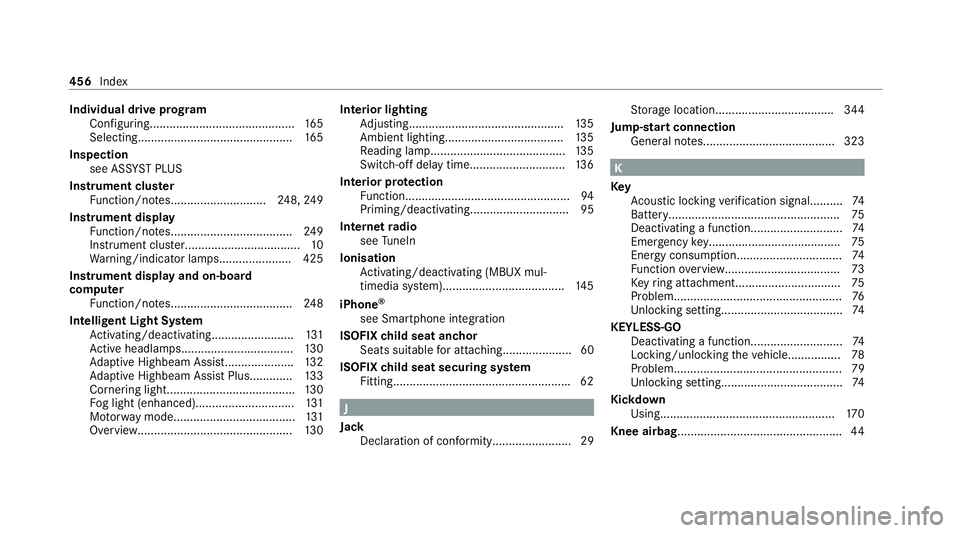
Individual drive prog
ram
Con figuring............................................ 16 5
Selecting............................................... 16 5
Inspection see AS SYST PLUS
Instrument clus ter
Fu nction/no tes............................. 248, 24 9
Instrument display Function/no tes..................................... 24 9
Instrument clus ter................................... 10
Wa rning/indicator lamps...................... 425
Instrument display and on-boa rd
compu ter
Fu nction/no tes..................................... 24 8
Intelligent Light Sy stem
Ac tivating/deactivating......................... 131
Ac tive headla mps.................................. 13 0
Ad aptive Highbeam Assist..................... 13 2
Ad aptive Highbeam Assist Plus............ .133
Cornering light....................................... 13 0
Fo g light (enhanced)..............................1 31
Mo torw ay mode..................................... 131
Overview............................................... 13 0Interior lighting
Adjusting............................................... 13 5
Ambient lighting.................................... 13 5
Re ading lam p......................................... 13 5
Switch-off del aytime............................. 13 6
Interior pr otection
Fu nction.................................................. 94
Priming/deactivating.............................. 95
Internet radio
see TuneIn
Ionisation Activating/deactivating (MBUX mul‐
timedia sy stem).....................................1 45
iPhone ®
see Smartphone integration
ISOFIX child seat anchor
Seats suitable for attaching..................... 60
ISOFIX child seat securing sy stem
Fitting..................................................... .62 J
Jack Declaration of conformity........................ 29 St
orage location.................................... 344
Jump-start connection General no tes........................................ 323 K
Key Acoustic locking verification signal.......... 74
Battery.................................................... 75
Deactivating a function............................ 74
Emergency key........................................ 75
Energy consumption................................ 74
Fu nction overview.................................. .73
Ke yring attachment................................ 75
Problem................................................... 76
Un locking setting.................................... .74
KEYLESS-GO Deactivating a function............................74
Locking/unlocking theve hicle................78
Problem................................................... 79
Un locking setting.................................... .74
Kickd own
Using.....................................................1 70
Knee airbag................................................. .44456
Index
Page 469 of 481

Snow
chains.............................................. 335
Soc ket (12 V)
Boot/luggage compa rtment.................. 121
Fr ont centre console.............................. 121
Soc ket (230 V)
Re ar...................................................... .122
Software update System updates.....................................2 63
Sound PRE-SAFE ®
Sound................................... 52
Wheels and tyres................................... 335
Sound menu Functions overview...............................2 96
Spare wheel see Emer gency spa rewheel
Specialist workshop
see Qualified specialist workshop
Specific absor ption rate ............................. 26
Speed limit for winter tyres
Setting................................................... 19 6
St andby mode
Ac tivating/deactivating......................... 183Fu
nction................................................ 183
St anding lights.......................................... 127
St art-off assi st
see Optimised acceleration
St art/s top button
Pa rking theve hicle................................1 77
St arting theve hicle...............................1 53
Switching on the po wer supply or
ignition................................................. .152
St art/s top function
see ECO start/ stop function
St arter battery
Charging (Remo teOnline)...................... 154
St arting
see Vehicle
St arting assi stance
see Jump -sta rt connection
St arting-o ffaid
see Hill Start Assist
St ationary heater/ventilation
Displ ays (remo tecontrol)...................... 14 9
Problems (remo tecontrol)..................... 15 0Re
placing the battery (remo tecon‐
trol)....................................................... 14 9
Setting (MBUX multimedia sy stem)....... 14 8
Setting (remo tecontrol)........................ 14 8
Switching on/off (control panel )........... 147
ST EER CONT ROL
Fu nction/no tes..................................... 189
Ste ering wheel
Ad justing (electrically)........................... 105
Ad justing (manually). ............................. 104
Buttons.................................................. 250
Ca re....................................................... 310
Operating the memory function............ 108
St eering wheel heater...........................1 05
Ste ering wheel gearshift paddles............ 16 8
Ste ering wheel heater
Ac tivating/deactivating......................... 105
St ow age areas
see Loading
see Stow age space
St ow age comp artments
see Loading
see Stow age space 466
Index